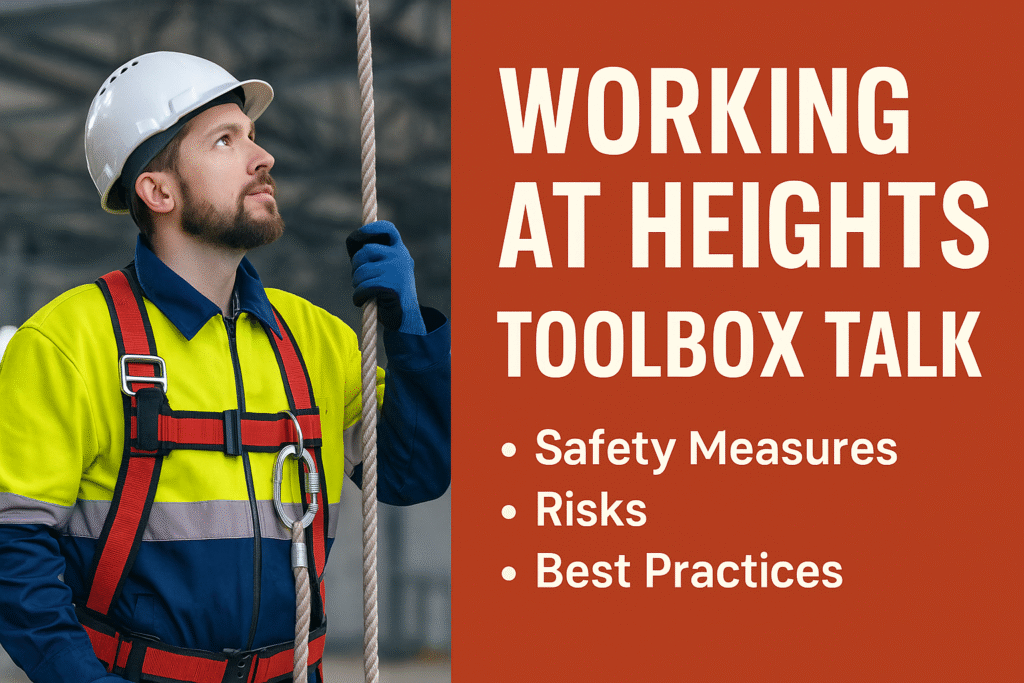
Working at Heights Toolbox Talk – Safety Measures, Risks, and Best Practices
Good morning team,
Today’s toolbox talk is about Working at Heights, one of the most dangerous activities in any workplace. Falls from height remain a leading cause of workplace fatalities worldwide. Whether you’re working on scaffolding, ladders, rooftops, or elevated platforms, safety must be your top priority.
1. Definition of Working at Heights
According to OSHA, working at height is any work where a person could fall and injure themselves if precautions are not taken — usually at a height of 4 feet (general industry) or 6 feet (construction) and above.
Examples:
- Climbing ladders
- Working on scaffolding
- Roofing activities
- Working near open edges or unprotected sides
- Using aerial lifts or cherry pickers
2. Common Hazards in Working at Heights
- Falls from unprotected edges – Roofs, scaffolds, platforms.
- Falling objects – Tools or materials falling from height.
- Unstable working platforms – Improperly erected scaffolds or ladders.
- Weather conditions – Wind, rain, ice increasing slip risks.
- Improper use of PPE – Harness not secured or faulty.
3. Risk Assessment for Working at Heights
Before starting any job:
- Identify all potential fall hazards.
- Evaluate the height, location, and conditions.
- Consider if the work can be done from the ground.
- Assess emergency access and rescue plans.
Key Risk Control Hierarchy:
- Avoid – Do the job from ground level if possible.
- Prevent – Use guardrails, scaffolds, and fall prevention systems.
- Minimize – Use harnesses and lanyards to reduce injury risk.
4. PPE Requirements for Working at Heights
- Full-body harness with double lanyard and shock absorber
- Hard hat with chin strap
- Non-slip safety boots
- High-visibility vest
- Gloves for grip and protection
- Eye protection if working with tools or dust
5. Safe Work Practices
- Always inspect ladders, scaffolds, and PPE before use.
- Ensure scaffolds are erected by trained, competent persons.
- Maintain three points of contact when climbing ladders.
- Keep work areas free from loose materials.
- Use tool lanyards to prevent falling objects.
- Never overload platforms.
- Avoid working in bad weather conditions.
6. Ladder Safety Rules
- Use ladders only for short-duration tasks.
- Position ladders at a 4:1 angle (1 foot out for every 4 feet up).
- Secure ladders at the top and bottom.
- Do not stand on the top rung.
7. Scaffold Safety Rules
- Erect only under competent supervision.
- Guardrails and toe boards must be installed.
- Platforms should be fully planked.
- Access ladders must be provided.
- Never move a scaffold while in use.
8. Emergency Preparedness
- Always have a rescue plan in place for fall incidents.
- First aid kits and trained personnel must be available.
- Workers must know how to respond if someone is suspended in a harness.
9. Real-Life Example
A worker fell from a 12-foot scaffold because his harness was not clipped to the lifeline. This could have been prevented with:
- Proper pre-work briefing
- Mandatory PPE check
- Supervision during work
10. Key Takeaways for Today’s Toolbox Talk
- Safety is everyone’s responsibility.
- Always plan, assess, and control risks before working at heights.
- PPE is your last line of defense — use it correctly.
- Follow company and legal safety guidelines at all times.
📋 Working at Heights Safety Checklist
| Item | Yes/No |
|---|---|
| Work area assessed for fall hazards? | |
| Can the work be done from ground level? | |
| Scaffolds inspected and secure? | |
| Ladders stable and positioned at correct angle? | |
| Guardrails and toe boards in place? | |
| Full-body harness worn and connected? | |
| Tools secured with lanyards? | |
| Weather conditions safe for work? | |
| Rescue plan in place? |
✅ Internal Link: Electrical Safety Toolbox Talk – Preventing Shocks, Fires, and Accidents
Fire Safety Toolbox Talk – Prevention, Response, and Evacuation
Heat Stress Prevention Toolbox Talk
10 Toolbox Talk Topics Every Safety Officer Should Use
How to Create a Safety Training Matrix for Your Workplace
✅ External Link: OSHA Fall Protection Standard 1926.501






















